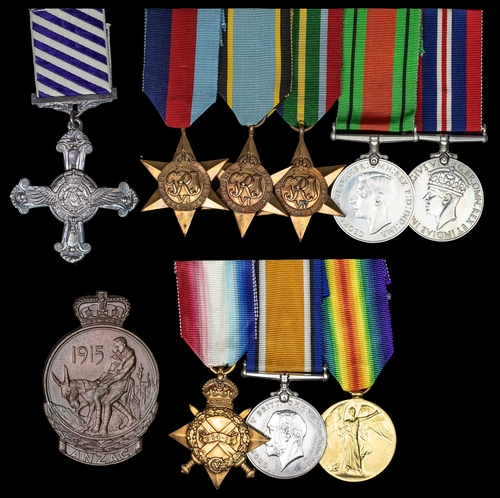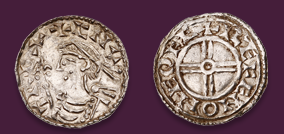
Auction: 25112 - Orders, Decorations and Medals - e-Auction
Lot: 732
Family group:
A rare Second World War D.F.C. group of six awarded to Warrant Officer E. M. Greaves, Royal New Zealand Air Force, who was decorated for his services as a Wireless Operator in Wellingtons of No. 156 Squadron, in which he flew 42 operational sorties in May-December 1942, latterly as a Pathfinder
Distinguished Flying Cross, G.VI.R., the reverse officially dated '1943', in its Royal Mint case of issue; 1939-45 Star; Air Crew Europe Star; Pacific Star; Defence and War Medals 1939-45, these five engraved 'N.Z. 404063 W./O. E. M. Graves, D.F.C., R.N.Z.A.F.', good very fine or better (6)
The Great War campaign group of three awarded to Lance-Corporal C. P. Greaves, New Zealand Expeditionary Force
1914-15 Star (6/1032 L./Cpl. C. P. Greaves, N.Z.E.F.); British War Medal 1914-20 (6/1032 L./Cpl. C. P. Greaves, N.Z.E.F.); Victory Medal 1914-19 (6/1032 L./C. Charles P. Greaves, N.Z.E.F.), together with his A.N.Z.A.C. 1915 medallion, engraved 'C. P. Greaves', in its fitted case of issue, with related lapel badge, the reverse numbered '6/1032', and his Silver War Badge, the reverse numbered 'N.Z. 882', polished and contact marks but generally very fine (6)
D.F.C. London Gazette 9 February 1943, the original recommendation states:
'This N.C.O. has completed 42 operational sorties between May 1942 and the present time [December 1942]. Thirty-Seven of them were over Germany, three over Italy and two over France.
During the time that this N.C.O. has been operating with his squadron, his ability and extreme keenness to carry out his duties efficiently have been marked as those of the highest order. Warrant Officer Greaves, by his zeal and devotion to duty, sets a high example to the other members of his crew and the squadron.'
Errol Mervyn Greaves was born at Malvern, Canterbury, New Zealand in March 1920, the son of a Great War veteran, Charles Pryor Greaves.
Following the outbreak of war, Errol joined in the Royal New Zealand Air Force and was embarked for the U.K., where he was posted to No. 156 Squadron, a Wellington unit operating out of Alconbury, Huntingdonshire, in early 1942; the unit would later move to R.A.F. Warboys, where it joined the Path Finder Force in August of the same year.
Meanwhile, Greaves's operational tour got underway in May, when he participated in three 'gardening' sorties off the French and German coasts, in addition to a trip to Essen. As it transpired, Essen featured prominently in his flying log book in June, for he and his crew participated in three further trips to the city, including the 'Thousand Bomber' raid on the 25th-26th. So, too, in four trips to Emden and one to Cologne. And by way of landmark sorties, July also witnessed them attacking Hamburg on two occasions at the time of the famous 'firestorm' raids, in addition to strikes against Duisburg, Saarbrucken and Dusseldorf.
Then in August 1942, the squadron converted to its new role in Path Finder Force (P.F.F.) and, still flying Wellingtons, it undertook its first P.F.F. missions in the following month. Hence - from Greaves's perspective - seven targets for marking of the heavily defended kind in September, among them Bremen (twice), Dusseldorf, Duisburg and Wilhelmshaven.
Having then been detailed to mark for raids on Aachen, Cologne, Kiel and Krefeld in October, Greaves and his crew undertook three trips to Italy in November, in addition to returning to Hamburg and an outing to Stuttgart. And in December they were assigned to Duisburg, Frankfurt, Mannheim and Munich.
Recommended for his D.F.C. at the end of the month, after completing 42 operational sorties, Greaves is known to have later joined the strength of No. 30 (N.Z.) Squadron at Gisborne. The squadron subsequently moved north to Papua New Guinea, from whence it flew numerous sorties in its Avengers against the Japanese in March-June 1944.
Greaves died in Marlborough province in December 1984.
Charles Pryor Greaves enlisted in the Canterbury Regiment in August 1914 and was embarked for Egypt that October. Subsequently deployed to Gallipoli, he was wounded on the 5 June 1915 but remained on duty. Having then been advanced to Lance-Corporal, he was wounded again on 7 August 1915, this time by a gunshot wound to his left foot. Evacuated in the hospital ship Delta, he was admitted to No. 1 Australian General Hospital in Cairo, where his wound - complicated by dysentery - was deemed serious enough for his repatriation. He was honourably discharged back in New Zealand in April 1916.
Subject to 20% VAT on Buyer’s Premium. For more information please view Terms and Conditions for Buyers.
Sold for
£2,200
Starting price
£700




